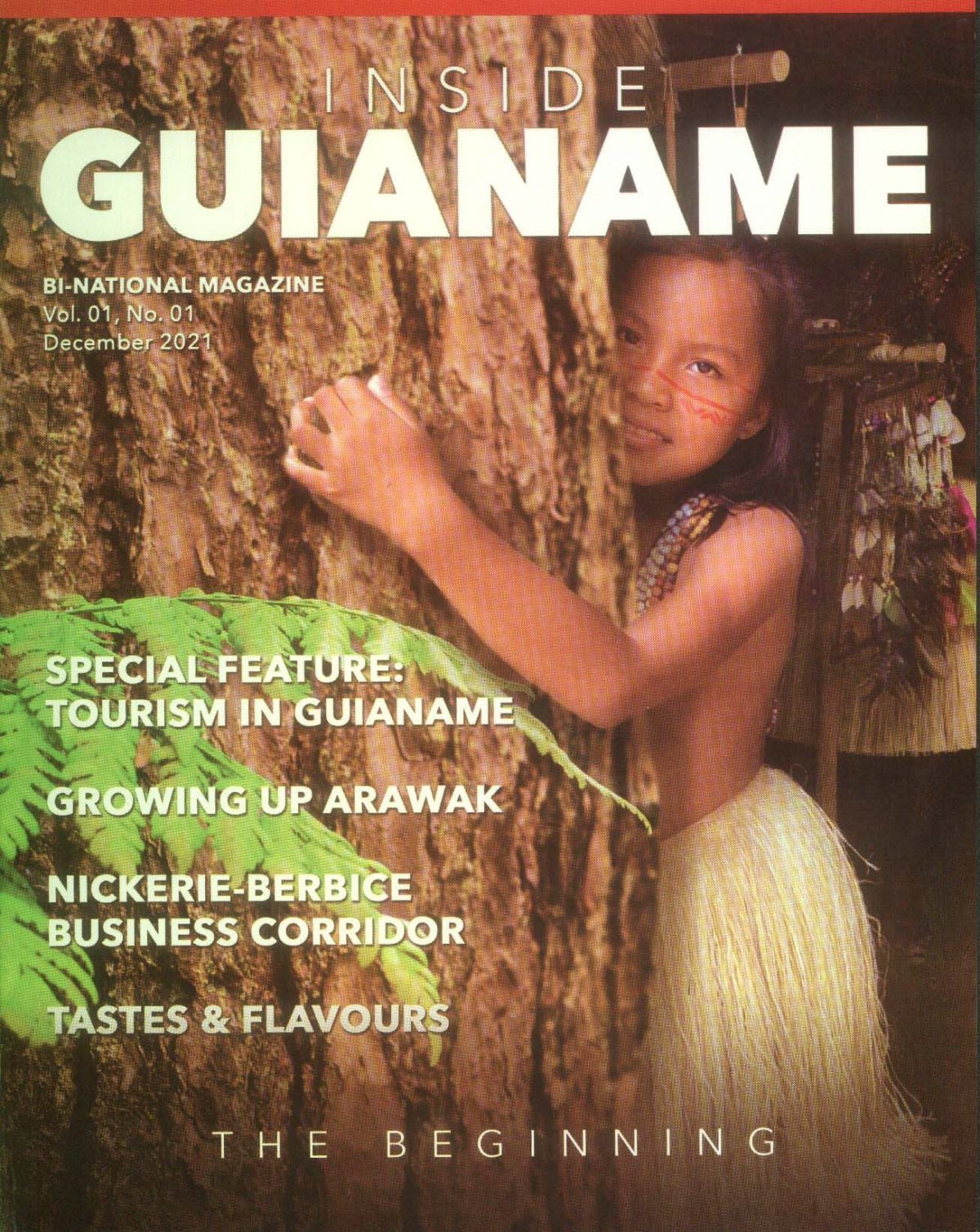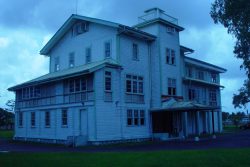 [Inside GUIANAME, Bi-National Magazine, Donald Sinclair and Sean F Taylor (Eds.), Vol.01, No. 01, George-town, December, 2021. 94pp.]
[Inside GUIANAME, Bi-National Magazine, Donald Sinclair and Sean F Taylor (Eds.), Vol.01, No. 01, George-town, December, 2021. 94pp.]
The Republic of Suriname carries deep and varied meanings for the people of the Republic of Guyana. It is a country that stands out prominently in the popular consciousness of Guyanese, as a close neighbour and friend, both in governmental diplomatic terms and in the common daily communion between people on the ground. Yet there are times when the name Suriname evokes fury as a foe claiming ownership of Guyanese land-space in a centuries-old border controversy which still spells harassment for fishermen on the Corentyne and neighbouring waters.
But the bonds are ancient and deep, going back to a history when the entire north-eastern shoulder of South America known geologically and geographically as the Guiana Shield and culturally as the Guianas, knew no boundaries. Several migratory Amerindian nations moved freely across what they called Guiana, before the advent of European colonial occupation which carved up the area into British Guiana, Dutch Guiana and French Guiana.
It is a story of forced migration and bonded labour, of colonialism and independence, of the beauty of landscape and Amazonian rainforests, of myth, literature, art, traditions and social history. Throughout all of this, there has been one continuing theme – the quest for untold wealth through the discovery of gold, first embarked upon by Sir Walter Ralegh in 1597. It seems though, in a way, that mythical and elusive reward has been turned into a reality with the publication of Inside GUIANAME in December, 2021.
Inside GUIANAME is what the publishers call a Bi-National magazine edited by Donald Sinclair and Sean F Taylor, with Volume 1, Number 1 coming off the press a few weeks ago, published in Georgetown and Paramaribo. It is an extremely attractive, polished, neatly put together, voluminous and rich glossy publication of some 94 pages of material.
Its contents link the neighbouring countries of Guyana and Suriname and may be regarded as a substantial collaboration with feature articles, academic contributions with information about both countries and possibilities for bilateral cooperation, told in tautly edited text illustrated by clean, striking and breathtaking photographs. It is impressive, and makes an impact.
Inside GUIANAME has content, packaging and appearance that will appeal to a range of audiences, interests and disciplines. While it will, undoubtedly, adorn offices for the casual leafing through by visitors, it is too weighty to be called a coffee-table magazine. It demands the attention of those with an interest in Guyana and Suriname as countries with incredible natural beauty, scientifically significant landscape, traditions, colourful people and ancient historical ties. This volume will appeal to the curious, but includes content of great value to tourism, including eco-tourism, nature and cultural tourism and national heritage. It also covers travel, academic articles, social history, geography, indigenous studies, food and the visual arts. Apart from the strong tourism connection, the magazine has a studied focus on the Indigenous presence which is so important in both Suriname and Guyana.
The magazine was founded by Sinclair, an academic, former sportsman, former diplomat and specialist in the field of tourism, who has served as national director of tourism and head of department at the University of Guyana. He is editor of the publication ReJoyce: A memorial celebration of the life of Joyce E. Sinclair, and the concept behind the founding of this bi-national magazine is further proof of the breadth of his imagination. The magazine’s co-editor is Sean F Taylor, a Guyana-born educator working and managing an academy in Paramaribo.
The title is an obvious coinage that integrates the names of the two nations with the concept behind the magazine. According to the Foreword: A Guyana Perspective, by Sinclair, “Inside GUIANAME focuses upon the Guyana-Suriname space, bringing to prominence all that defines and sustains the connections between the two countries and their inhabitants. For many decades Guyanese and Surinamers eyed each other as distant relatives; speaking different languages, governed under different political systems, practising different cultures but enjoying a strange bond, with many interests in common. The editors of Inside GUIANAME see this bond evolving as a synergy.”
The Foreword also has a twin – A Suriname Perspective by Vijoya Da Vita of Suriname, who observes: “Inside GUIANAME is being launched at a time of extreme change. We are reminded every day of our own mortality, of the fragility of our shared ecosystems. Our efforts are valuable. But our greenness is invaluable” as she stresses the value of the shared ecology in the nations of the Giuanas.
What proves to be very important in this inaugural issue, is the background to the Guianas, provided by historian Tota Mangar, to start off with an understanding of the area “of approximately half a million square miles . . . that stretches between the Amazon and the Orinoco” where the social focus of the magazine lies. The brief historical account is fairly thorough, including the interesting theories about how the area got its name, with possible origins in the languages of both the Arawaks and the Warraus. Interestingly, the common belief about a word meaning “land of many waters” might just not be entirely accurate. But Mangar’s history enlightens the reader about the colonial period right up to the present.
Thus armed with a preliminary historical introduction to the three Guianas, the readers have a minefield of knowledge to look forward to in the other articles. The strong tourism constituency is served by a number of contributions, foremost among them being the interventions of UG’s Head of Tourism Studies Camille Ishmael – “Linking Tourism Education and Training”, an input on “Iwokrama – River Lodge” from Dr Raquel Thomas, “Wilderness Explorers” by Claire Thorne and Sinclair’s Viewpoint, “Guianame a Single Destination”
However, what is there from a few travel writers helps to reinforce that theme as well as provide further valued information. For instance, there is “Nickerie – Berbice Business Corridor” by Henry McDonald, which helps to fix a very distinct feel of identity to the magazine. The region known as Nickerie in western Suriname has always been treated as the poor stepsister to capital Para-maribo, but it nevertheless features prominently with people on the ground commuting almost daily between Berbice and Nickerie which has been growing as an agricultural and commercial centre. Of similar importance is the feature on “Suriname – Diversity in Nature and Culture”.
Identity is indeed a strong point of the magazine, especially when one considers the testimony of Candace Phillips, “Growing Up Arawak”. She declares “I am a proud Lokono. A descendant of many who have walked before me”. It is a first person account of growing up in that area in Guyana’s North West around Santa Rosa, Moruca, and Mabaruma.
Language is an issue in most of these Lokono regions, and Phillips mentions some of the reasons why the native language is threatened. Linguistics is among the most rewarding studies across the Guianas, except for the anxiety surrounding moribund mother tongues. It is therefore of great interest to find that Inside GUIANAME carries a feature on Sranan, one of the national indigenous languages of Suriname. This one, however, is a creole language that is not in danger of disappearing. It certainly fortifies the magazine’s keen sense of identity, and carries even greater weight because the editors saw the value of including a translation of the article in Sranan. It is quite a study, with a history of the language, which benefitted from a published Sranan-English Dictionary (by C L Schumann) as early as 1783.
One area not overwhelmingly covered is culture – to be more precise, literature. There is, however, a feature on visual arts and articles on sports. It is rewarding to see “Art-Splash – MURUSCAPE: The Splendour That Is Suriname” in which the paintings of a Surinamese artist are featured. Unfortunately, the artist is not named. It is said that the selections are from watercolour paintings done in 2014 on the bank of the Suriname River in Paramaribo and printed from the collection owned by Dr A Murugesan. The non-identification of the painter is a glaring omission.
The inaugural appearance of Inside GUIANAME is important in a climate in which periodical magazines and journals have a reputation of not appearing after volume 1, or suffering discontinuations after a few issues. Fortunately, it appears that Inside GUIANAME has so far proven to be commercially viable and page 94 of Volume 1 Number 1, has already announced and named some six “Second Issue Highlights” expected to appear in the already planned Volume 1 Number 2 in July/August, 2022. The magazine’s Paramaribo office is scheduled to be formally opened on March 22, and the third issue is slated to be presented in December, 2022. Inside GUIANAME seems to be here to stay.
For the excellent quality of its production, the coverage of a few areas of interest and its creation of a bi-national identity, it is definitely worth reading and can be recommended.










